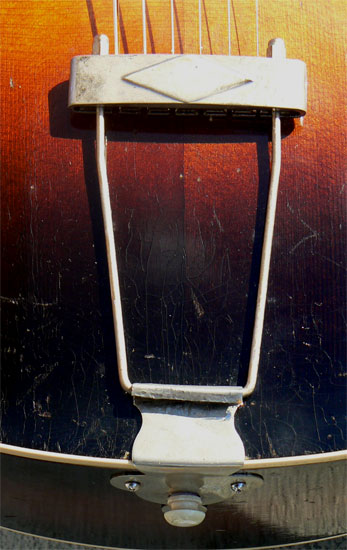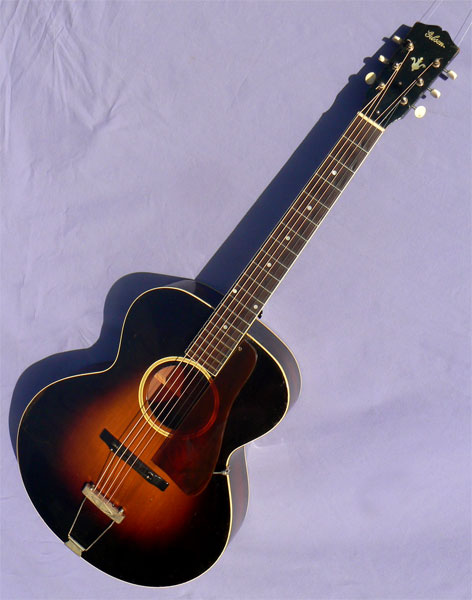 1935 Gibson L-75
1935 Gibson L-75 Home / Instruments /Accessories / Ordering / Tips / Friends
archtop.com
 1935 Gibson L-75
1935 Gibson L-75
Status: For pricing and hold status for this instrument, please check our Instruments page here. If this instrument does not appear on the Instruments page it has been sold, and is no longer available. Photos and descriptions of Previously Sold instruments may by found here. To be notified of examples of this or any other model in the future, please contact [email protected].
FON #: 199-A, stamped on neck block
Body size at lower bout: 16". Scale length: 24 3/4" Nut Width: 1 3/4"
Materials: Handcarved bookmatched solid spruce top; solid Honduran mahogany neck, back and sides, bound Brazilian rosewood fingerboard.
Hardware: Original compensated ebony bridge and nickel pickguard bracket. Vintage correct hardware includes aged nickel raised-diamond trapeze tailpiece, aged nickel Waverly Sta-Tite style 16:1 tuners, contoured swirl tortoise pickguard, with original guard included.
Notes: One of Gibson's rarest models, the elusive L-75 went through a different permutation in each of its first five years of production. Debuting in 1932, the L-75 premiered with a pear-shaped 14 3/4" flat-backed maple body, and an arched spruce soundboard with f-holes. By the following year, the body had been converted to mahogany and fitted with a fanciful pearloid fingerboard and peghead, ala Gibson's contemporaneous Century of Progress flat top. By 1934, the body of was enlarged to the 16" size shown here, and the neck fitted with a dot inlay Brazilian rosewood fingerboard.
The year this rare example left the factory, the L-75 was redesigned with a round sound hole, but retained the flat mahogany back. And finally in 1936, the back was curved in a delicate arch, to complete its resemblance to it's cousin, Gibson's venerable L-4, which itself had been converted from round to f-holes that year as well. Confused? Well it was the Great Depression, and the boys from Kalamazoo were throwing lots of stuff at the wall.
Though otherwise identical to the 14 fret L-4, the L-75 was built with a solid mahogany body, unique in the Gibson line. The resulting design made it one of the lightest archtops ever produced, and lent the voice an appealing warmth and clarity. In addition, this guitar was finished with a distinctive lateral sunburst on the sides, a pattern rarely seen on any Gibson branded guitar, as well as the short lived vase motif peghead inlay.
This handsome guitar sports a formally shaded dark Cremona sunburst over a nicely bookmatched handcarved solid spruce top, with a ribbon figured Honduran mahogany body, Brazilian rosewood fingerboard, and solid mahogany neck with a French heel. The original adjustable ebony bridge is in place, and the guitar has been fitted with vintage correct aged nickel hardware including the raised-diamond trapeze tailpiece, smooth premium Waverly 16:1 tuners, and a contoured pickguard in thick translucent swirl tortoise.
The neck is comfortable, with a traditional vee profile, and the action is smooth and low over fine pro fretwork and a fresh high precision setup. The top is carved very delicately, and the featherweight instrument barely tips the scales at an astounding 4lb even. This feather light construction is a clue to the extraordinary voice of this instrument. Clear, throaty and unusually transparent, the guitar simply thunders in the bass register, with an extremely 'wet' natural reverb in the treble range. Combining the superior projection of the arched soundboard with the enhanced bass response and sustain of a flat top, this guitar is an extremely versatile instrument suitable for a wide variety of musical styles.
Well played and well cared for, the guitar shows playwear mostly confined to the upper neck, with some typical scattered nicks and dings, but little in the way of pick or buckle wear. A pair of hairline cracks on the back have been soundly cleated and resealed, along with another short one hidden underneath the pickguard. Though there is no trace of this scarce model in any Gibson catalog after 1936, a few seem to have eked out as late as 1939, after which the model simply faded in obscurity: in some 30 pls years, this is only the second example of the model we've had the pleasure to present.
Given how rarely this Depression Era guitar is seen in the vintage market, there can be little doubt that this remarkable find remains one of the few known examples in existence. The next one could be some time in coming: one only, call now.
Setup: The frets have been precision leveled, recrowned and polished; trussrod tension and neck relief adjusted; bridge height adjusted; bridge compensation set; string slots at nut and bridge inspected and recut as necessary; bridge foot contour inspected and fit to top as necessary; bridge radius inspected and recurved as necessary; bridge wheels and tuners lubricated; fingerboard and bridge oiled; body and neck cleaned and hand polished.
Case: Black plush lined hardshell case.
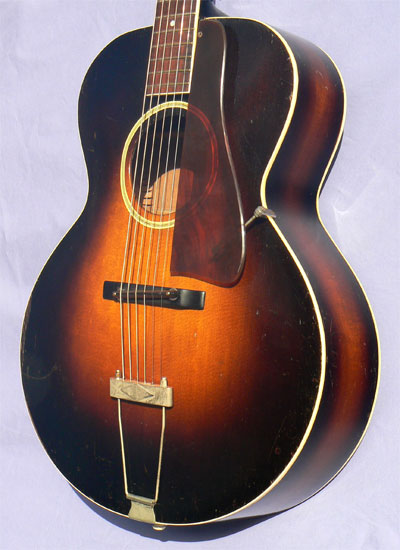
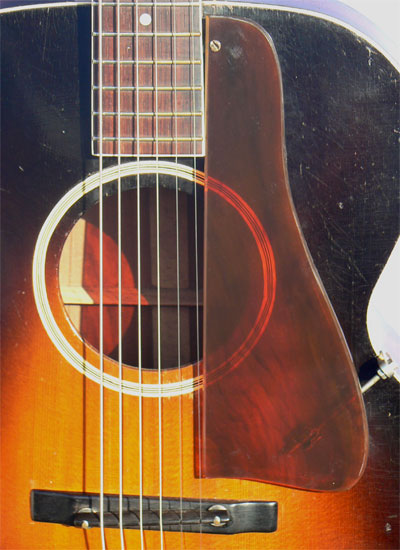
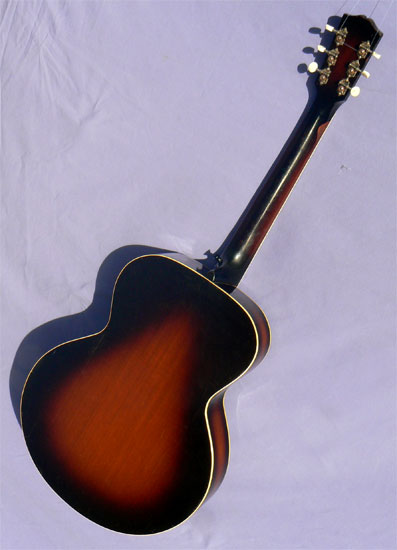
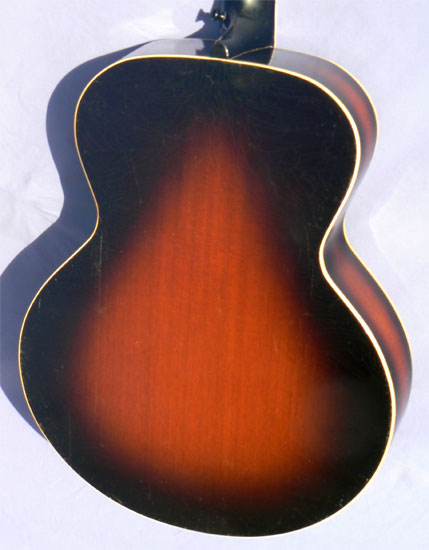
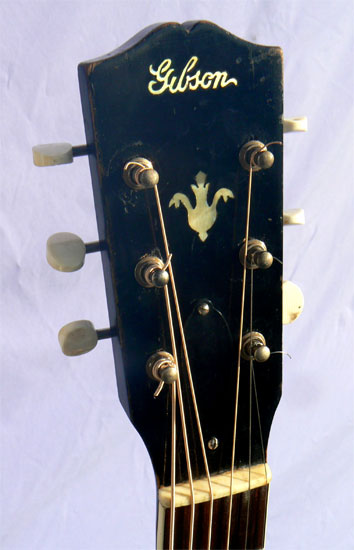
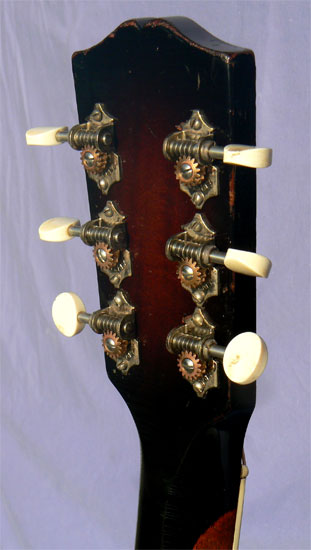
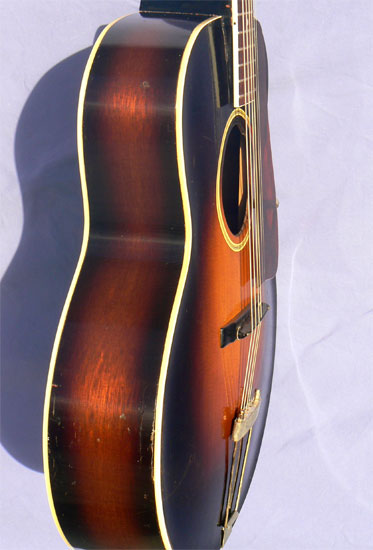 Home / Instruments /Accessories
/ Ordering / Tips / Friends
Home / Instruments /Accessories
/ Ordering / Tips / Friends 